'THE LITTLE ENGINE WITH THE BIG PULL' is the slogan by which the Jowett car is best remembered. It is remarkable that this small manufacturer, from Yorkshire in the UK, managed to have only the one basic design in production for nearly half a century ... and was then able to turn its back on its former staid image and produce one of the more exciting family cars of the post World War 2 austerity era.
Benjamin and William Jowett
The company's founders, Benjamin and William Jowett, were brothers who ran a cycle works at Manningham Lane, Bradford, at the turn of the century. As their trade increased, so they were able to buy machine tools and undertake outside contracts. In 1901, they made their first tentative step into the motor industry by producing an early 'go-faster' conversion in the shape of a 55-degree V-twin engine to replace the 6-hp De Dion and 6½-hp Aster units which were in common use in many contemporary voiturettes.
These engines proved remarkably durable: as late as 1914 one was still being used to drive a wood mill. In 1904, the brothers built a second type of power unit, this time a 950 cc straight-three with air cooling, overhead valves and a five-bearing crankshaft. It featured what was claimed to be a new type of ignition, in which the strength of the spark was intensified by use of a spark gap. The engine could also run in either direction!
The following year, Ben and Willie decided to become motor manufacturers, designing what they claimed was 'the world's first light-car', intended to operate at a cost of a penny a mile. Apart from its tiller steering, the little Jowett car was an advanced-looking vehicle, whose appearance would not have caused comment ten or fifteen years later. It weighed 6 cwt (less than half the weight of a Mini), and had a water-cooled horizontally opposed two-cylinder engine of 816cc, in unit with a three-speed gearbox; final drive was by worm gear.
The brothers claimed that their experiments had proved that the horizontally opposed engine was the equal in balance of any power unit with fewer than six cylinders, and to prove this they would stand a pencil on end on the radiator cap for minutes at a time. The little cars (the brothers built themselves one each) attracted much attention, but at that time they received an order from Alfred Angas Scott to build the first of the famous Scott motor cycles, and fur some years this work prevented them from putting the car into production.
However, in 1910, Scott opened his own factory at Saltaire, and the Jowetts decided that it was time they put their light-car into series production, and opened a works for this purpose in Grosvenor Road, Bradford. They hedged their bets, however, by retaining a number of car agencies, such as Crossley. The design of the car was gradually improved up to the outbreak of war, the most notable improvement being the substitution of wheel for tiller steering.
Manufacturing Munitions During The War
During the war Jowett concentrated on the production of munitions, mainly shell components and cases. After the war, an expansion programme was implemented, and a new factory built at Idle, in what was then open country at the end of the tram route out of Bradford. The work was completed in the winter of 1919-1920, the company was renamed Jowett Cars Limited, and the first of the post-war models began to come off the assembly line in May 1920.
The standard body style was a two-seater with a dickey seat; to take advantage of the 1920 Road Traffic Act, which introduced the £1 per horsepower taxation rate, the bore was slightly increased to bring the car from 6.4 to 7 hp, as it would still be taxed at £7. Swept volume was increased to 907 cc, but the design of the engine, with its fixed cylinder heads that made routine maintenance a matter of some difficulty, remained unchanged. So, too, save for the fitment of larger drums, did the primitive braking system. However, if the Jowett car had a number of annoying idiosyncracies, it had one redeeming virtue: it was exceptionally economical to operate, with a petrol consumption that could be as frugal as 55 miles to the gallon.
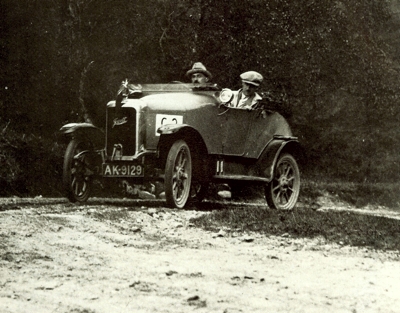 A 7hp Jowett taking part in the 1922 Scottish Six Days Trial.
A 7hp Jowett taking part in the 1922 Scottish Six Days Trial.
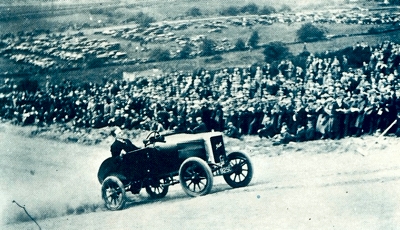 A Jowett 2 short-wheelbase 7hp competing in the 1923 Yorkshire (UK) hill-climb event.
A Jowett 2 short-wheelbase 7hp competing in the 1923 Yorkshire (UK) hill-climb event.
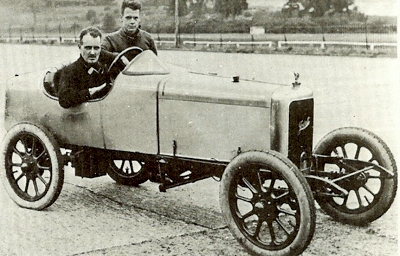 1928 Jowett 907cc Flat Twin.
1928 Jowett 907cc Flat Twin.
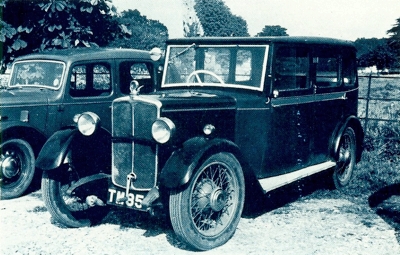 1932 Jowett Ling Fabric Sedan. This model was fitted with Jowett's amaxing little 7hp horizontally opposed two-cylinder 907cc engine.
1932 Jowett Ling Fabric Sedan. This model was fitted with Jowett's amaxing little 7hp horizontally opposed two-cylinder 907cc engine.
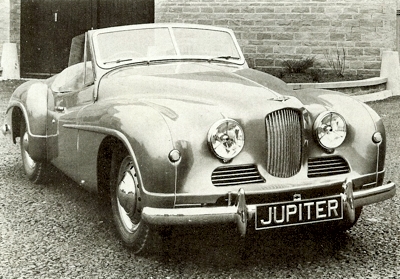 1950 Jowett Javelin. The Javelin used a space-frame designed by Eberan von Eberhorst, who had previously worked for Auto Union. The Javelin was powered by a 1486cc horizontally opposed engine.
1950 Jowett Javelin. The Javelin used a space-frame designed by Eberan von Eberhorst, who had previously worked for Auto Union. The Javelin was powered by a 1486cc horizontally opposed engine.
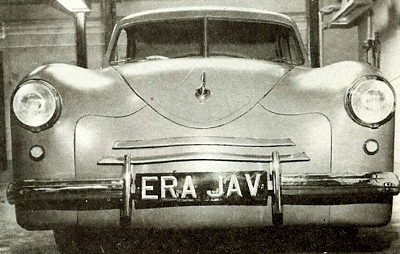 Jowett's ERA Javelin prototype. It featured a highly tuned version of the standard 1.5 liter four cylinder horizontally opposed overhead valve engine.
Jowett's ERA Javelin prototype. It featured a highly tuned version of the standard 1.5 liter four cylinder horizontally opposed overhead valve engine. |
The Roomiest Body Ever Conceived On A 7 hp Chassis
Moreover, the little engine developed its big pull at astonishingly low revolutions, so that hill-climbing powers were equal to those of a larger car. For such reasons, the demand for Jowetts, which up to then had been rather parochial, was soon nationwide; a further factor in the marque's growing popularity was the introduction, in 1923, of the Full-Four-Seater, on a lengthened (8 ft 6 in) wheelbase, with what its makers claimed was 'the roomiest body ever conceived on a 7 hp chassis'. Certainly, it made its 7 hp contemporary from Austin look absurdly poky, and could carry four adults at less than a halfpenny a mile each. The output had reached IS cars a week and was rising steadily.
The next year, the Jowett Light-Four appeared, which offered a chummy four-seater body on the short chassis, primarily intended for two children in the rear; the car was sprung accordingly, but offered reasonable comfort for adults-provided they sat in front! The company's first saloon appeared in 1925; the flat-twin engine, claimed Jowett, was the smallest ever fitted to a real coach accommodating four big adults. Production had now reached 65-75 cars weekly, and the marque's appeal was further widened by the introduction of the Long Two-Seater on the 8 ft 6 in wheelbase.
Jowett Wait and See
All the bodies fitted to Jowett cars were designed and built in the Idle works, aluminum panelling helping to keep weight down. The robustness of the little Jowett was amply proved in 1926. Frank Gray, the former MP for Oxford, challenged the British Motor industry to build him a car that was capable of crossing the 'uncrossable' heart of Africa, from the Atlantic coast to the Red Sea. Within four days, Jowett had sold Mr Gray and his fellow-explorer, Mr Sawyer, two standard long-wheelbase 7 hp two-seaters, fitted with 'Safari' bodies in place of the dickey seats. 'In other words,' claimed Jowett, 'we ensured touring comfort for the driver and two native boys, mechanic and cook, while providing a roomy flat body behind'.
The two cars, which had been christened Wait and See, set off from Lagos on 16 March 1926, following a route which was largely devoid of roads, mostly over desert, and short of water throughout. For 1600 miles, between Maidugari and El Obeid, there were not even advance dumps of petrol and supplies, and the cars had to carry all their needs with them, pulling loaded trailers in addition to the stores which were carried on the cars themselves.
The 3800 mile journey took just 60 days, and in May they arrived in Massawa, on the Red Sea coast, after an eventful journey during which Gray had even freed a slave girl from desert traders. Gray was delighted with the cars' performance, and wrote a booklet which the company used to promote the Jowett range. Although this endurance run proved that Jowetts could go, they were still rather reluctant to stop; and since the majority of cars was now being produced with four-wheel braking, the Jowett was becoming increasingly at a disadvantage.
The Jowett Gasket-Blower
From around 1923, Ben Jowett had been operating an experimental workshop and, in the 1926 - 1928 period, he was increasingly preoccupied with developing an efficient four-wheel-braking system for the cars. After some rather unsatisfactory trials, a rod-operated system was at last perfected by their new designer, S. C. Poole (ex-Clyno, ex-Singer), and introduced at the 1928 Motor Show. This was fitted as standard on the new Long Saloon, which had a fabric body in the most up-to-date style.
Less satisfactory was the fate of the sports model, which appeared that year. This, too, was a result of Ben Jowett's experiments, and featured a specially tuned power unit which was set further back in the chassis than usual, to permit the use of a shortened propeller shaft. Handsome two-seater bodywork with a pointed tail and swept wings was fitted; this model was used to test a high-compression version of an improved power unit with detachable cylinder heads - and became known as a notorious gasket-blower. Nevertheless, J. J. Hall and A. H. Grimley used one of these cars to take the 12-hour Class G record at Brooklands in 1928, at an average speed of 54.9 mph, despite three blown gaskets, and a small production run of Sports Jowetts (around 15) was undertaken, although the purchasing public seemed unimpressed.
A Penny A Mile In The Chummy
The 1929 Motor Show saw the introduction of the detachable cylinder heads as a standard feature; the booming production of Jowett cars meant that production had risen to as many as 95 cars a week, and two-tone color schemes were introduced. With the depression just around the corner, the cheapness of Jowett motoring was a considerable sales point, and the company advertised that they offered motoring at a 'penny a mile' inclusive of tax and insurance.
There was an attempt, in 1929, to produce a car to meet the specification of that contemporary chimera, the £100 four-seater, but although they cut costs as much as they could, Jowett failed to produce their austere, rear-wheel-brakes-only Chummy at less than a hundred guineas. This, reckoned Ben and Willie, was too narrow a margin to safeguard the tradition of Jowett workmanship, and the model was dropped. Car sales tailed off noticeably in the summer of 1930, but the company went ahead with the production of their 1931 prototypes, which had a new design of radiator shell, 'pressed from stainless steel, plus improvements to the engine specification.
Then, on the night of Friday 2 September, disaster struck: fire broke out in the factory and gutted the entire production area. Fortunately, 20 or so pre-production 1931 cars had survived the holocaust, six of these were refurbished as Olympia Show exhibits. By November, salvage work had progressed sufficiently to permit the production of two or three light-vans weekly, but car production was not resumed until the following March. By the end of the summer, the factory was once again operating at virtually full strength, with 50-60 vehicles a week coming off the production lines.
The Jowett Kestrel and Weasel
The company even found time to develop its 1932 models; the fabric saloon models were now discontinued, and coach built bodies standardised. 'In 1931,' remarked the company naively, 'the arrival of the folding head or sunshine roof cheered us a lot. The Jowett Long Saloon now had this amenity'. Limited production of touring two and four-seaters continued, nevertheless. The only new 1933 model was a streamlined saloon, the Kestrel, fitted with Jowett's new four-speed gearbox. In the mid-season, it was joined by a sporting variant, the twin-carburetor Weasel. A centrifugal clutch and freewheel were available in 1935 as aids to gear-changing and economy, while production was running at between 85 and 95 cars a week by this time.
Ben Jowett then decided it was time to introduce a new power unit; not unconnected with this was the fact that an odd-looking saloon bearing the name La Roche on its unfamiliar radiator was occasionally seen driving around the hills of Idle after dark. Under its bonnet was a vertical four-cylinder engine, with inlet-over-exhaust valve design, plus a Wilson pre-selector gearbox. Three of these La Roches were built before the project was abandoned, but the Jowett brothers had something far more characteristic on the drawing boards. This was the horizontally opposed four, which was first listed on 1936 models.
Rated at 10 hp, it had a swept volume of 1166 cc, could cover 35 miles at 30 mph on a gallon of petrol, and had a top speed of 65 mph. The first flat-four models suffered from aggressively streamlined styling, with sharply raked radiators and windscreens, and neither the £195 Jupiter nor the de-luxe £205 Jason sold in the expected quantities, so that they were soon replaced by an improved 10 hp model. This was the new flat-four engine in the old flat-twin chassis, and was endowed with staid saloon bodywork. 1936 was an eventful year for Jowett: it was the last year of the old 7 hp model, as the flat-twin was now bored out to give a capacity of 946 cc and a tax rating of 8 hp; it was the last pre-war year in which Jowett produced an open model. Production was now 90 cars a week, not far short of Willie Jowett's ambition of 100 cars built each week. Still ultra-conservative, Jowett did not introduce a synchromesh gearbox until the advent of the 1940 models.
The new transmission proved troublesome: it was possible to engage two gears at once, and the gears were liable to slip out of mesh. In the spring of 1940, car production was suspended, and the company turned to war work. They built capstan lathes and small components for Merlin engines and Barracuda, Battle and Fulmar aircraft, and developed the anti-mine flail for the Sherman tank as well as other types of munitions, while twin-cylinder engines were built by the dozen to power generating sets.
The Jowett brothers retired in mid 1940, and the company came under the direction of Calcott Riley, who as early as 1942 was planning the post-war Jowett. This was designed by Gerald Palmer, who had just joined the company from MG. He devised a car powered by a new horizontally opposed 1486 cc engine. The smooth body lines, vaguely reminiscent of the Lincoln Zephyr, concealed the fact that the car was designed to be built by the simplest possible methods in and around the factory.
The Jowett Javelin
Suspension was by torsion bars all round, with independent springing at the front. By the end of the war, the prototypes had been thoroughly tested, and Briggs Motor Bodies had opened a plant at Doncaster expressly to supply body-shells for the new car, named the Javelin. Production, however, restarted in 1946 with the Bradford van, which used the old flat-twin power unit, now phased out for passenger-car use. The last prototype Javelin took part in the 1946 Jubilee Celebrations, and production cars began to emerge, mostly onto the export market in the early months.
The Javelin caused quite a furore, it was anything but a typically British design, being more reminiscent of the best Continental practice. It proved its worth in January 1949 when a works-entered car won the 1.5-liter class of the Monte Carlo Rally, crewed by its designer, Gerald Palmer, T. C. Wise and T. C. Harrison. A few months later, a Javelin driven by Tommy Wisdom and Anthony Hume won its class in the Spa 24 hour race. Now that the Javelin was a proven success, Palmer left, his place being taken by ex-Aston-Martin designer Roy Lunn. Lunn laid down designs for a two-seater sports version of the Javelin, which appeared at the 1949 Motor Show as the Jupiter; it had a space frame designed by Eberan von Eberhorst, ex-Auto Union and then with ERA, which gave excellent roadholding qualities. The two Tommies- Wisdom and Wise - drove one of the first Jupiters in the 1950 Le Mans 24-hour race, sett.ing a new It-liter race record, and winning their class at 75.84 mph, just one of many sporting successes for these new Jowetts.
Demand from both home and overseas markets was keen, and even in the austere climate of 1951, when the company celebrated its Golden Jubilee, a car was being made every 12 minutes. Jowett boasted: 'We intend to stay in markets where we are established, continuing to offer even finer value for the discriminating owner'. It was not to be, though. Having failed to learn their lesson from the 1940 transmission failures, Jowett persisted in building their own gearboxes, instead of purchasing tried and tested units from Henry Meadows. The new transmission ran true to its ancestry by failing in all sorts of frustrating ways, resulting in warranty claims, loss of confidence and falling sales. Briggs Motor Bodies found themselves with undelivered body-shells filling their works like the aftermath of some automotive Sorcerer's Apprentice and, before long, Jowett were overwhelmed by financial problems, closing down for good in 1954.
Somewhere around 30,000 Javelins and 1200 Jupiters had been built. At the time of the company's demise, Roy Lunn was working on an exciting new sports model, the R4, with glassfibre bodywork of advanced concept. The last word, however, must go to the old flat-twin, which was still being fitted to the Bradford van when the company died, nearly 50 years after the same basic design had appeared in Ben and Willie Jowett's original tiller-steered light car in 1905.
Also see: Jowett Car Reviews
